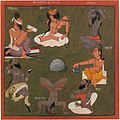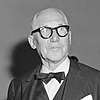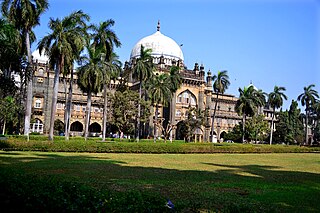
Chhatrapati Shivaji Maharaj Vastu Sangrahalaya, (CSMVS) originally named Prince of Wales Museum of Western India, is a museum in Mumbai (Bombay) which documents the history of India from prehistoric to modern times.

The Greco-Buddhist art or Gandhara art is the artistic manifestation of Greco-Buddhism, a cultural syncretism between Ancient Greek art and Buddhism. It had mainly evolved in the ancient region of Gandhara, located in the northwestern fringe of the Indian subcontinent.

The Salar Jung Museum is an art museum located at Dar-ul-Shifa, on the southern bank of the Musi River in the city of Hyderabad, Telangana, India. It is one of the notable National Museums of India. Originally a private art collection of the Salar Jung family, it was endowed to the nation after the death of Salar Jung III. It was inaugurated on 16 December 1951.

Indian art consists of a variety of art forms, including painting, sculpture, pottery, and textile arts such as woven silk. Geographically, it spans the entire Indian subcontinent, including what is now India, Pakistan, Bangladesh, Sri Lanka, Nepal, and at times eastern Afghanistan. A strong sense of design is characteristic of Indian art and can be observed in its modern and traditional forms.
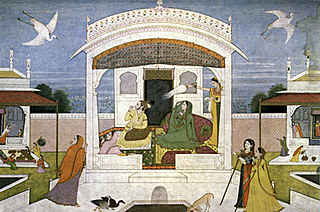
Pahari painting is an umbrella term used for a form of Indian painting, done mostly in miniature forms, originating from the lower Himalayan hill kingdoms of North India and plains of Punjab, during the early 17th to mid 19th century, notably Basohli, Mankot, Nurpur, Chamba, Kangra, Guler, Mandi and Garhwal. Nainsukh was a famous master of the mid-18th century, followed by his family workshop for another two generations. The central theme of Pahari painting is depiction of eternal love of Hindu deities Radha and Krishna. A distinct lyricism, spontaneous rhythm, softness, minute intricate details of composition, and intense perception and portrayal of human emotions and physical features distinguish the Pahari miniatures from the other miniature schools like Deccan, Mughal and Rajasthani-Rajput.

The Lahore Museum is a museum located in Lahore, Punjab, Pakistan. Founded in 1865 at a smaller location and opened in 1894 at its current location on The Mall in Lahore during the British colonial period, Lahore Museum is Pakistan's largest museum, as well as one of its most visited ones.

The National Museum in New Delhi, also known as the National Museum of India, is one of the largest museums in India. Established in 1949, it holds a variety of articles ranging from pre-historic era to modern works of art. It functions under the Ministry of Culture, Government of India. The museum is situated on Janpath. The blue–print of the National Museum had been prepared by the Gwyer Committee set up by the Government of India in 1946. The museum has around 200,000 works of art, mostly Indian, but some of foreign origin, covering over 5,000 years.

The Peshawar Museum is a museum located in Peshawar, capital of Pakistan's Khyber Pakhtunkhwa province. The Peshawar Museum is notable for its collection of Buddhist artwork dating from the ancient Gandhara region.

Sobha Singh was an artist from Punjab, India.

Basohli is a town near Kathua in Kathua district in the union territory of Jammu and Kashmir, India. It is situated on the right bank of River Ravi at an altitude of 1876 ft. It was founded by Raja Bhupat Pal sometime in 1635. It was known for the palaces which are now in ruins and miniatures paintings. The Battle of Basoli was fought in this region.
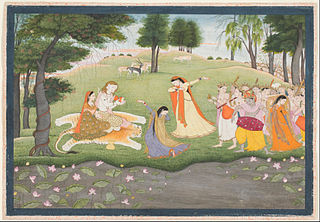
Kangra painting is the pictorial art of Kangra, named after the Kangra State, a former princely state of Himachal Pradesh, which patronized the art. It became prevalent with the fading of Basohli school of painting in mid-18th century, and soon produced such a magnitude in paintings both in content as well as volume, that the Pahari painting school, came to be known as Kangra paintings.

Mohinder Singh Randhawa or M. S. Randhawa was an Indian historian, civil servant, botanist, and author. He played major roles in the establishment of agricultural research in India, the Green Revolution in India, resettling Punjabis uprooted by Partition as the Director-General of Rehabilitation, establishing the city of Chandigarh and documenting the arts of Punjab, the history of agriculture in India. A biographer, Gulzar Singh Sandhu, gave him the sobriquet Punjab da Chhewan Dariya, the sixth river of Punjab.

Lalbhai Dalpatbhai Museum, abbreviated L. D. Museum, is a museum of Indian sculptures, bronzes, manuscripts, paintings, drawings, miniature paintings, woodwork, bead work and ancient and contemporary coins in Ahmedabad, Gujarat, India.

The Seated Buddha from Gandhara is an early surviving statue of the Buddha discovered at the site of Jamal Garhi in ancient Gandhara in modern-day Pakistan, that dates to the 2nd or 3rd century AD during the Kushan Empire. Statues of the "enlightened one" were not made until the 1st century CE. Before that, Buddha were generally represented by aniconic symbols. Like other Gandharan, Greco-Buddhist art, and Kushan art, the statue shows influence from Ancient Greek art depicting Buddhist themes. The sculpture is now in room 22 of the British Museum, catalogued as 1895, 1026.1.

State Museum, Lucknow is a prominent museum located in the capital city of Uttar Pradesh, India. The museum is currently located in the Nawab Wajid Ali Shah Zoological Gardens, Banarasi Bagh, Lucknow. The museum was established in 1863 from the collection of Colonel Saunders Alexius Abbott, and was given the status of ‘Provincial Museum’ before being renamed the ‘State Museum’ in 1950.

Vijay Sharma is an Indian painter and art historian, known for his expertise in the Pahari school of miniature painting. He was honored by the Government of India, in 2012, with the fourth highest Indian civilian award of Padma Shri.
Brijinder Nath Goswamy was an Indian art critic and historian, and a vice chairman of the Sarabhai Foundation of Ahmedabad, which runs the Calico Museum of Textiles. Goswamy was best known for his scholarship on Pahari painting and Indian miniature paintings. He was the author of over 20 books on arts and culture, including Sakti Burman: A Private Universe, a monograph on the life and works of Sakti Burman, renowned Bengali painter and Masters of Indian Painting 1100-1900, a treatise on Indian miniature art. The Government of India awarded him the fourth highest civilian award of the Padma Shri in 1998 and followed it up with the third highest honour of the Padma Bhushan in 2008.

The Saptarishi Tila statue, also called the Kambojika statue, is a statue of a woman found in the Saptarishi mound in Mathura. The statue is life-size and is now in the Mathura Museum. The statue was discovered by Bhagawanlal Indraji, at the same time and place as another important artifact, the Mathura lion capital, dated to the beginning of the 1st century CE.
The Government College of Arts, Chandigarh is an art institute in Chandigarh, India. Established in 1951 by SL Prashar, it offers professional education in art to students from over 68 years. This institute is one among the first three art institutions of India. It has a history of almost 132 years, initially, it was initially established as Mayo School of Industrial art in 1875 for purpose to provide industrial drawing as the world was on industrial revolution. John Lockwood Kipling was appointed as the first principal of the institution, which is now active as National College of Arts in Lahore. It came up on 16 August 1951 as splinter Mayo School of Arts, Lahore in Pakistan after Partition of India. In 1951 it was first established as Government School of Art and craft at Shimla, the capital of Punjab and subsequently Govt. College of art and craft, Chandigarh. On re-organization of Punjab, the control came under Chandigarh Administration. This institution is situated in Sector 10 C, adjoining the Government Museum and Art Gallery, Chandigarh.
Indian miniature paintings are a class of paintings originating from India. Made on canvases a few inches in length and width, the Indian miniatures are noted for the amount of details that the artist encapsulates within the minute canvas frame; and the characteristic sensitivity with which the human, divine and natural forms are portrayed. They depict a variety of topics such as legends and myths, human passions and pains, aspirations, and physicality. From their origins in cave paintings, to the later Mughal and Pahari schools, the Indian miniatures represent a diversity of styles and themes, varying between the religious and the secular. Today most of these forms have perished, and are no longer practiced, due to the decline in royal patronage, and subsequent changes in the country's socio-cultural scenes. However, several of these canvases today survive in museums and private collections, defining India, her lifestyle and the aesthetic idiom of her past, as well as the essence of her soil, her creative imagination, colours, and thought.














